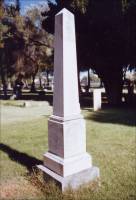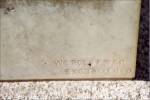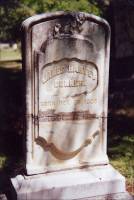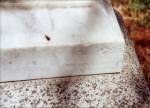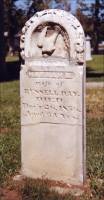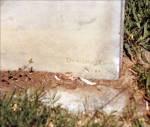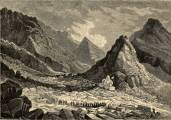
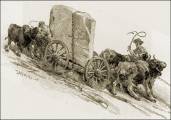

From Quarry to Cemetery Monuments
Some California Monument Companies & Individuals (Continued)
William Boyne (1837-1909) - Wm. Boyne & Company, Sacramento*
(* Please note that only portions of the “William Boyne” section will be presented here. For the full story, visit the “Boyne” section our web site.)
The following information is from Leeanna Rossi’s notes on the Gold Rush Carvers. She wrote Headstones of the Gold Rush Era: Sculpting Masterpieces in Marble, Golden Notes, vol. 43, number 3, Fall 1997, Sacramento Co. Historical Society, Sacramento, CA, 1997, available at the Old Sacramento City Cemetery.
According to Leeanna’s Rossi’s research notes, William Boyne was born in Canada in March 1837. He came to California some time in 1866. He married Anne E. Murphy of Ireland in Sept. 1866, and they had three children. He was naturalized in Sacramento County in February 1874. His description was given as: Height: 5 feet, 6.5 inches; complexion: light; eyes: blue; hair: light.
In 1867 Boyne was listed in the city directory as working as a “stone cutter.” During the years 1869, 1871/1872 and 1874 he was working for Aitken & Co. In 1875 William Boyne partnered with A. C. Thompson to form the company named “Boyne and Thompson, Marble Dealers,” at 204 K Street; residence at 238 K Street. In 1878 the company name was changed to “Boyne and Vosper Marble Works,” located at the same address. In 1880 this company employed seven employees. In the following years Boyne’s company name and partners changed: 1882-1884: William Boyne & Co., Marble and Granite Works (with George Holberg); 1884: Boyne & Co., Marble Works; 1885: Wm. Boyne Marble Works; and in 1889-1892: Wm. Boyne Marble and Granite Works. In 1992 Boyne was listed as a “commercial traveler” for Carlaw Brothers Marble Works. He was not listed as employed in the Sacramento stone industry again until 1904 when he was listed as a “marble dealer.” According to Leeanna Rossi’s book, William Boyne’s business tended toward “smaller, less ornate headstones,” and he was very prolific.
William Boyne died of cancer of the liver in Sacramento on January 17, 1909, at the age of 72. His obituary stated that he belonged to the I.O.O.F.Cemetery Stones in the Woodland Cemetery that Include the Carver Name “Boyne”
Patrick James (P. J.) Devine (1832-1870)*
John Charles (J. C.) Devine (1831-1912) & James Henry Devine (1846-?)*
Carved names found on the Cemetery Stones: Devine, Fecit, Sac.; & J. C. Devine, Sac.
(* Please note that only portions of “Devines’” story will be presented here. For the full story, visit the “Devine (Various)” section our web site.)
The following information is from Leeanna Rossi’s notes on the Gold Rush Carvers. She wrote Headstones of the Gold Rush Era: Sculpting Masterpieces in Marble, Golden Notes, vol. 43, number 3, Fall 1997, Sacramento Co. Historical Society, Sacramento, CA, 1997, available at the Old Sacramento City Cemetery.
Patrick James (P.J.) Devine was born in 1832 in Galway, Ireland. He arrived in California in 1854, and he opened the second marble works in Sacramento in August, 1855. In 1857 his brother Thomas Devine joined the business, and the firm name changed to “Devine & Brother Premium Marble Works” until 1862. P.J. Devine was a recognized sculptor who received “many commissions for busts, medallions, and monuments commemorating the lives of public officials.”
As early as 1860, Patrick J. (P.J.) Devine discovered several marble quarries along the Cosumnes River near Columbia. The white marble P.J. Devine discovered near Columbia was not as heavily veined as the Indian Diggings marble discovered by Israel Luce. With the discovery of the more pure white marble, the demand for both types of marble increased.
According to a January 1870 article in the San Francisco Alta, P.J. Devine died in San Francisco of consumption, a disease that he had suffered from for the last four to five years of his life. “While his burial place has not be established, it is believed that he was interred in San Francisco.”
Rossi writes that P.J. Devine’s sculpting style was very distinctive tending more to the “massive and flowery,” and his customers tended to be the more well-to-do. P.J.’s cousin, John Charles Devine, also created ornate headstones and monuments, although J.C. Devine produced more monuments than headstones.
John Charles (J.C.) Devine (who arrived in California in 1860) and James Henry Devine (who arrived in California in 1864) opened the third marble works in Sacramento under the company name of “J.C. Devine & Brother.” In her book, Leeanna Rossi states that they were cousins to P. J. Devine, although they never worked or lived with one another. John and James Devine continued in their partnership until John Charles Devine’s death in 1912 in Sacramento. He was buried in St. Joseph’s Cemetery in Sacramento. James Henry Devine also died in Sacramento, but the date of death and place of burial are unknown at this time.
Cemetery Stones in the Woodland Cemetery that Include the Carver Name “Devine”
Commercial use of material within this site is strictly prohibited. It is not to be captured, reworked, and placed inside another web site ©. All rights reserved. Peggy B. and George (Pat) Perazzo.
